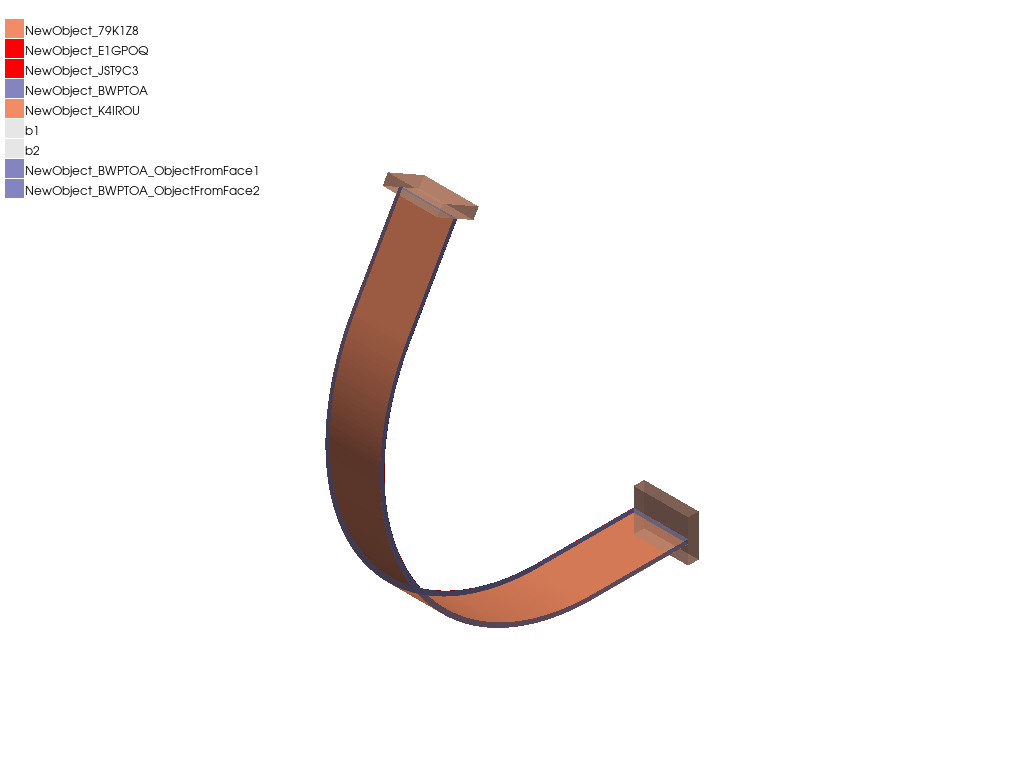Note
Go to the end to download the full example code.
HFSS: flex cable CPWG#
This example shows how you can use PyAEDT to create a flex cable CPWG (coplanar waveguide with ground).
Perform required imports#
Perform required imports.
Set AEDT version#
Set AEDT version.
aedt_version = "2024.1"
Set non-graphical mode#
Set non-graphical mode.
You can set non_graphical either to True or False.
non_graphical = False
Launch AEDT#
Launch AEDT 2023 R2 in graphical mode.
hfss = pyaedt.Hfss(version=aedt_version,
solution_type="DrivenTerminal",
new_desktop=True,
non_graphical=non_graphical)
hfss.change_material_override(True)
hfss.change_automatically_use_causal_materials(True)
hfss.create_open_region("100GHz")
hfss.modeler.model_units = "mil"
hfss.mesh.assign_initial_mesh_from_slider(applycurvilinear=True)
True
Create variables#
Create input variables for creating the flex cable CPWG.
total_length = 300
theta = 120
r = 100
width = 3
height = 0.1
spacing = 1.53
gnd_width = 10
gnd_thickness = 2
xt = (total_length - r * radians(theta)) / 2
Create bend#
Create the bend. The create_bending method creates a list of points for
the bend based on the curvature radius and extension.
def create_bending(radius, extension=0):
position_list = [(-xt, 0, -radius), (0, 0, -radius)]
for i in [radians(i) for i in range(theta)] + [radians(theta + 0.000000001)]:
position_list.append((radius * sin(i), 0, -radius * cos(i)))
x1, y1, z1 = position_list[-1]
x0, y0, z0 = position_list[-2]
scale = (xt + extension) / sqrt((x1 - x0) ** 2 + (z1 - z0) ** 2)
x, y, z = (x1 - x0) * scale + x0, 0, (z1 - z0) * scale + z0
position_list[-1] = (x, y, z)
return position_list
Draw signal line#
Draw a signal line to create a bent signal wire.
position_list = create_bending(r, 1)
line = hfss.modeler.create_polyline(points=position_list, material="copper", xsection_type="Rectangle",
xsection_width=height, xsection_height=width)
Draw ground line#
Draw a ground line to create two bent ground wires.
gnd_r = [(x, spacing + width / 2 + gnd_width / 2, z) for x, y, z in position_list]
gnd_l = [(x, -y, z) for x, y, z in gnd_r]
gnd_objs = []
for gnd in [gnd_r, gnd_l]:
x = hfss.modeler.create_polyline(points=gnd, material="copper", xsection_type="Rectangle", xsection_width=height,
xsection_height=gnd_width)
x.color = (255, 0, 0)
gnd_objs.append(x)
Draw dielectric#
Draw a dielectric to create a dielectric cable.
position_list = create_bending(r + (height + gnd_thickness) / 2)
fr4 = hfss.modeler.create_polyline(points=position_list, material="FR4_epoxy", xsection_type="Rectangle",
xsection_width=gnd_thickness, xsection_height=width + 2 * spacing + 2 * gnd_width)
Create bottom metals#
Create the bottom metals.
position_list = create_bending(r + height + gnd_thickness, 1)
bot = hfss.modeler.create_polyline(points=position_list, material="copper", xsection_type="Rectangle",
xsection_width=height, xsection_height=width + 2 * spacing + 2 * gnd_width)
Create port interfaces#
Create port interfaces (PEC enclosures).
port_faces = []
for face, blockname in zip([fr4.top_face_z, fr4.bottom_face_x], ["b1", "b2"]):
xc, yc, zc = face.center
positions = [i.position for i in face.vertices]
port_sheet_list = [((x - xc) * 10 + xc, (y - yc) + yc, (z - zc) * 10 + zc) for x, y, z in positions]
s = hfss.modeler.create_polyline(port_sheet_list, cover_surface=True, close_surface=True)
center = [round(i, 6) for i in s.faces[0].center]
port_block = hfss.modeler.thicken_sheet(s.name, -5)
port_block.name = blockname
for f in port_block.faces:
if [round(i, 6) for i in f.center] == center:
port_faces.append(f)
port_block.material_name = "PEC"
for i in [line, bot] + gnd_objs:
i.subtract([port_block], True)
print(port_faces)
[7391]
[7391, 7586]
Create boundary condition#
Creates a Perfect E boundary condition.
Create ports#
Creates ports.
Create setup and sweep#
Create the setup and sweep.
setup = hfss.create_setup("setup1")
setup["Frequency"] = "2GHz"
setup.props["MaximumPasses"] = 10
setup.props["MinimumConvergedPasses"] = 2
hfss.create_linear_count_sweep(setup="setup1", units="GHz", start_frequency=1e-1, stop_frequency=4,
num_of_freq_points=101, name="sweep1", save_fields=False, sweep_type="Interpolating")
<pyaedt.modules.SolveSweeps.SweepHFSS object at 0x00000187CD4B43D0>
Plot model#
Plot the model.
my_plot = hfss.plot(show=False, plot_air_objects=False)
my_plot.show_axes = False
my_plot.show_grid = False
my_plot.plot(
os.path.join(hfss.working_directory, "Image.jpg"),
)

True
Analyze and release#
Uncomment the hfss.analyze command if you want to analyze the
model and release AEDT.
hfss.release_desktop()
True
Total running time of the script: (0 minutes 49.100 seconds)